市场资讯及洞察
%20(1).jpg)
Pine Script是TradingView提供的专属编程语言,旨在帮助交易者创建自定义指标和策略,进行回测和实时分析。作为一种轻量级但功能强大的语言,Pine Script 使用户能够在TradingView平台上实现个性化的技术分析工具。要在TradingView上使用Pine Script,首先需要在图表界面打开“Pine 编辑器”。在编辑器中,用户可以编写脚本并将其应用于图表。脚本可以是指标(如移动平均线、RSI 等)或策略(用于回测交易信号)。
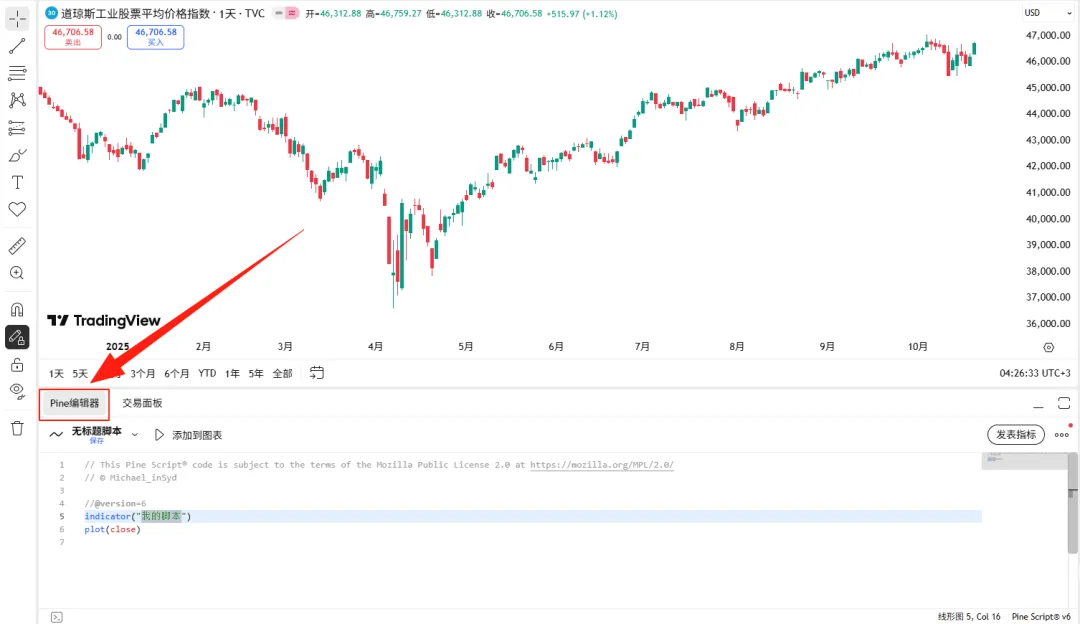
官方文档提供了详细的函数和示例,帮助用户理解和应用各种功能。此外,TradingView拥有一个活跃的社区,用户可以在“公共库”中浏览和使用他人分享的脚本。通过搜索功能,可以找到各种类型的指标和策略,满足不同的交易需求。许多脚本是开源的,用户可以查看其源代码,学习他人的编程思路,并根据自己的需要进行修改和优化。介绍完 Pine Script 的基础功能后,接下来我们将动手实战,编写第一个简单的均线技术指标,并将其应用到K线图中。
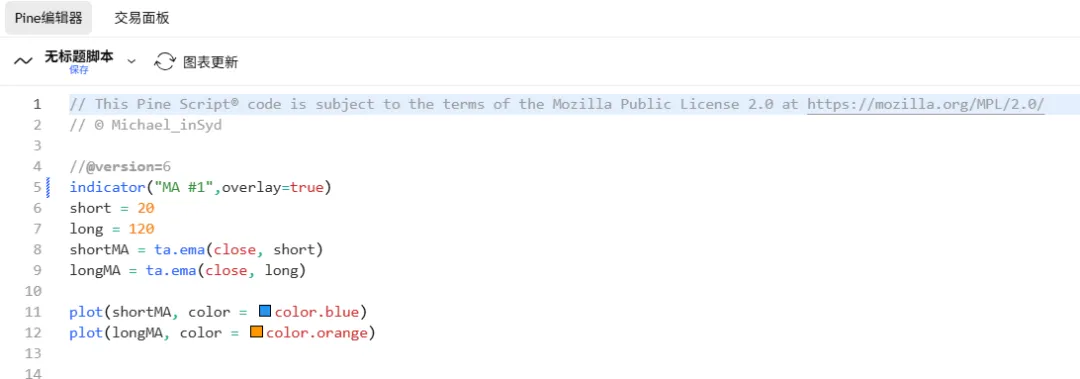
indicator("MA #1",overlay=true)short = 20long = 120shortMA = ta.ema(close, short)longMA = ta.ema(close, long)plot(shortMA, color = color.blue)plot(longMA, color = color.orange)这段Pine Script脚本实现了在TradingView的主图(也就是 K 线图)上绘制两条不同周期的指数移动平均线(EMA)。它的作用是帮助交易者观察市场的短期与长期趋势,是很多技术分析中常见的基础工具。首先,脚本通过indicator("MA #1", overlay=true)定义了指标的基本信息。其中"MA #1"是该指标在图表上显示的名称,而overlay=true表示该指标将直接绘制在价格图上,而不是在单独的副图中显示。接下来,脚本定义了两个变量short=20和long=120,分别代表短期和长期均线的周期。周期指的是计算均线时所参考的历史K线数量,比如在日线图中,20就代表20个交易日。之后,使用ta.ema(close, short)和ta.ema(close, long)计算出这两个周期的EMA值,分别赋值给shortMA 和longMA。EMA是一种常用的平滑移动平均方式,相较于简单移动平均(SMA),它对最新的数据更敏感,因此在趋势判断上更及时。最后,通过plot(shortMA, color=color.blue) 和 plot(longMA, color=color.orange) 将两条 EMA 线绘制到图表上,分别使用蓝色和橙色加以区分。这样,交易者在图表中就可以直观地看到短期与长期的价格趋势,有助于进行技术分析、识别趋势方向或寻找潜在的买卖点。

整体而言,这段代码是非常适合初学者的 Pine Script 示例,简洁清晰,同时具备实用性,为后续扩展更多交易逻辑(如信号提示、策略测试等)打下良好基础。
免责声明:GO Markets 分析师或外部发言人提供的信息基于其独立分析或个人经验。所表达的观点或交易风格仅代表其个人;并不代表 GO Markets 的观点或立场。
联系方式:
墨尔本 03 8658 0603
悉尼 02 9188 0418
中国地区(中文) 400 120 8537中国地区(英文) +248 4 671 903
作者:
Michael Miao | GO Markets 悉尼中文部


There has been plenty of conjecture about where oil is going to go in 2025 and we would suggest that the recent climb in Brent crude oil prices above $80 per barrel reflects an intensifying mix of geopolitical uncertainty. The main 3 uncertainties driving oil have been the impact of the U.S. presidential election, the escalation of the Middle East tensions and anticipation surrounding the OPEC+ meeting on December 1. These factors are clearly shaping short-term oil price dynamics, although some uncertainties have begun to ease, namely the election and the Middle East, but they still hold sway.
Thus let’s explore revised demand and supply projections as the industry anticipates a potential surplus in 2025 and the enactment of the Trump administrations Drill. Drill. Drill policy. 1.
Middle East Tensions Geopolitical tensions in the Middle East have posed a notable risk to the global oil supply particularly the conflicts involving Israel and Iran and the potential disruptions it would cause to OPEC’s 5 largest producers. However, so far, oil infrastructure in the region has largely remained intact, and oil flows are expected to continue without significant interruptions. While exchanges between regional powers remain a potential flashpoint, there is a general consensus that the two countries have stepped back from the worst.
The base case for this point is to assume stability in oil transportation routes and infrastructure. However, as we have seen during periods of unrest this year the consequences of a flare up for global oil prices can be considerable, underscoring the market's sensitivity to even minor shifts in Middle Eastern stability. 2. U.S.
Presidential Election – Drill Baby Drill The U.S. presidential election outcome has had a muted effect on oil prices – so far. This is likely due to President-elect Trump's policies regarding the energy being ‘speculative’. But there are several parts of his election platform that will directly and indirectly hit oil over the coming 4 years.
First as foremost – its platform was built on ‘turning the taps back on’ and ‘drill, drill, drill’. Under the current administration US shale gas and new oil exploration programs have come under higher levels of scrutiny and/or outright rejections. The new administration wants to reverse this and enhance the US’ output.
This is despite consensus showing these projects may return below cost-effective rates of return if oil prices remain low and the cost of production above competitors. Second, although President-Elect’s proposed tariff policies—ranging from 10-20 per cent on all imports, with higher rates on Chinese goods—could slow global trade, the net effect on the oil market is uncertain. Consensus estimates have the 10 per cent blanket tariff reducing U.S.
GDP growth by 1.4 per cent annually, potentially cutting oil demand by several hundred thousand barrels per day. If enacted, this bearish influence could counterbalance any potential bullish effects on prices. The third issue is geopolitics again – this time the possible reinstatement of the "maximum pressure" campaign on Iran that was enacted in the first Trump administration.
If the Trump administration imposes secondary sanctions on Iranian oil buyers, Iran’s exports could drop as they did during the 2018-2019 period, when sanctions sharply curtailed oil shipments. Such a development would likely tighten global supply and drive prices higher. These three issues illustrate possible impacts U.S. policy could have in 2025 and illustrate how contrasting economic and geopolitical factors could sway oil prices in unpredictable ways.
It again also explains why reactions in oil to Trump’s victory are still in a holding pattern. 3. What about OPEC? This brings us to the third part of the oil dynamic, OPEC and its upcoming Vienna convention on December 1.
The OPEC+ meeting presents another key variable, currently the consensus issue that member countries face - the risk of oversupply in 2025 and what to do about it. Despite Brent crude hovering above $70 per barrel, a price point that has normally seen production cut reactions, consensus has OPEC+ maintain its production targets for 2025, at least for the near term. We feel this is open for a significant market surprise as there is a growing minority view that OPEC+ could cut production by as much as 1.4 million barrels.
With Brent prices projected to stabilise around the low $70s, how effectively OPEC+ navigates this delicate balance between production and demand remains anyone’s guess and it's not out of the question that the bloc pulls a swift change that leads to price change shocks. December 1 is a key risk to markets. Where does this leave 2025?
According to world oil sites global supply and demand projections for 2025 suggest a surplus of approximately 1.3 million barrels a day, and that accounts for the recent adjustments to both demand and OPEC supply which basically offset each other. With this in mind and all variables remaining constant the base case for Brent is for pricing to sag through 2025 with forecasts ranging from as low as $58 a barrel to $69 a barrel However, as we well know the variables in the oil markets are vast and are currently more unknown than at any time in the past 4 years. For example: Non-OPEC supply growth underperformed in 2024, which is atypical; over the past 15 years, non-OPEC supply has generally exceeded expectations.
With Trump sworn in in late-January will the ‘Drill, Drill, Drill policy be enacted quickly and reverse this trend? This may prompt a supply war with OPEC, who may respond to market conditions by revising its output plans downward, which would tighten supply and support prices. In short its going to be complex So consensus has an oil market under pressure in 2025 with a projected surplus that could bring Brent prices into the mid-$60s range by the year’s end.
But that is clearly not a linear call and the global oil market faces an intricate array of challenges, and ongoing monitoring of these trends will be essential to refine forecasts and gauge the future direction of prices, something we will be watching closely.


Why you need to understand this market concept to improve your trading: Market Correlation For new traders and experienced traders, it can be daunting trying to find the best assets to trade. Whether it be equities, foreign exchange or indices, traders should be trying to have as many factors pointing in their favour as possible when entering a trade. These factors can include, the general trend of the individual asset, the price action at the time of entering the trade, candlestick patterns, use of technical indicators, among many others.
However, one thing that all traders should know about and understand is correlation. What is Correlation? Correlation is the pattern or relationship of how one asset performs relative to another asset.
In statistics, there are mathematical measures of correlation including covariance, correlation coefficients and other terms to describe the relationship of one asset to another. These methods can also be used to quantify asset correlations. A correlation between assets can be positive negative or uncorrelated.
Understanding which relationship between different assets can help provide some indication of the way in which an assets price will go. Below is a diagram that shows how the return of assets can be plotted against each other and the potential relationship. For example, imagine that there are two gold companies Gold company A Gold company B Assume that the price of their shares is perfectly, positively, correlated.
This means that when gold company A’s share price rises by 1% company B’s share price will also rise by 1%. This same price action will occur in reverse if the price of company A falls by 1%. Now in practice no two assets are perfectly correlated.
However, two or more assets may be very strongly correlated. Therefore, identifying how correlated certain assets are and how the price of one impact on the other can be a powerful tool. What creates correlation?
Strong correlation between assets usually occurs because the price of the different assets is material impacted by very similar factors. For instance, two companies in Australia may be more correlated than one company in Australia and one company in the USA. This is because geographically the Australian companies will be affected the local economic conditions.
This may include things such as inflation, taxation policies and other geographical specific conditions. Other factors that can influence the correlation include similarity of the assets or a company’s business operations, being in the same sector or a range of other factors. For example, see the correlation between the ‘Big 4’ banks in Australia below.
It can be seen due to how similar the businesses are and the conditions of which they operate in the pattern on returns are almost identical. Index correlation An important phenomenon to understand is the law of averages and big numbers. Essentially, if large companies are grouped together then they act as a good proxy for the overall market or a specific sector.
This essentially is what an ETF or and Index is. Therefore, as it represents how most individual companies are performing, most companies will be to a degree correlated to the overall market index or relevant sector index or ETF. Size matters Another important thing to understand about how correlation works is that smaller assets or companies will tend to correlate towards the performance of the major players within the sector.
For instance, in the technology sector, smaller technology company’s such as zoom will likely be correlated to larger companies such as Apple and Microsoft by virtue of being in the same sector. Correlations do not just occur in equities and are prevalent in FOREX and commodities. Correlation can be found between growth assets such as the Nasdaq Index which is a technology heavy Index and growth currencies such as the AUD or NZD.
Similarly, more stable assets such as the Dow Jones will likely be more correlated to commodities such as oil, they represent more stable industry and manufacturing sectors. How does it improve your trading? By simply being aware of the direction of the correlated assets, a trader is better able to trade with underlying trend and momentum.
This is vital when trying to optimise edge and improve trading accuracy. It can also equally show when a stock is underperforming or overperforming. For instance, if the general trend of a sector leader is trading 5% higher over a certain period, and a smaller company in the sector is trading at 10% higher it is outperforming the ‘sector’ and understanding why this occurs is an important step into deciphering what is driving price action.
Having a good understanding of how assets correlate can also help find potential trading opportunities earlier than others. This is because by following a sector it becomes easier to see which assets still may have room to shift their price. Ultimately, if a trader can develop their identification of patterns of correlation and the reasons for the relationships between different assets it can provide a trader with a much stronger and accurate edge.
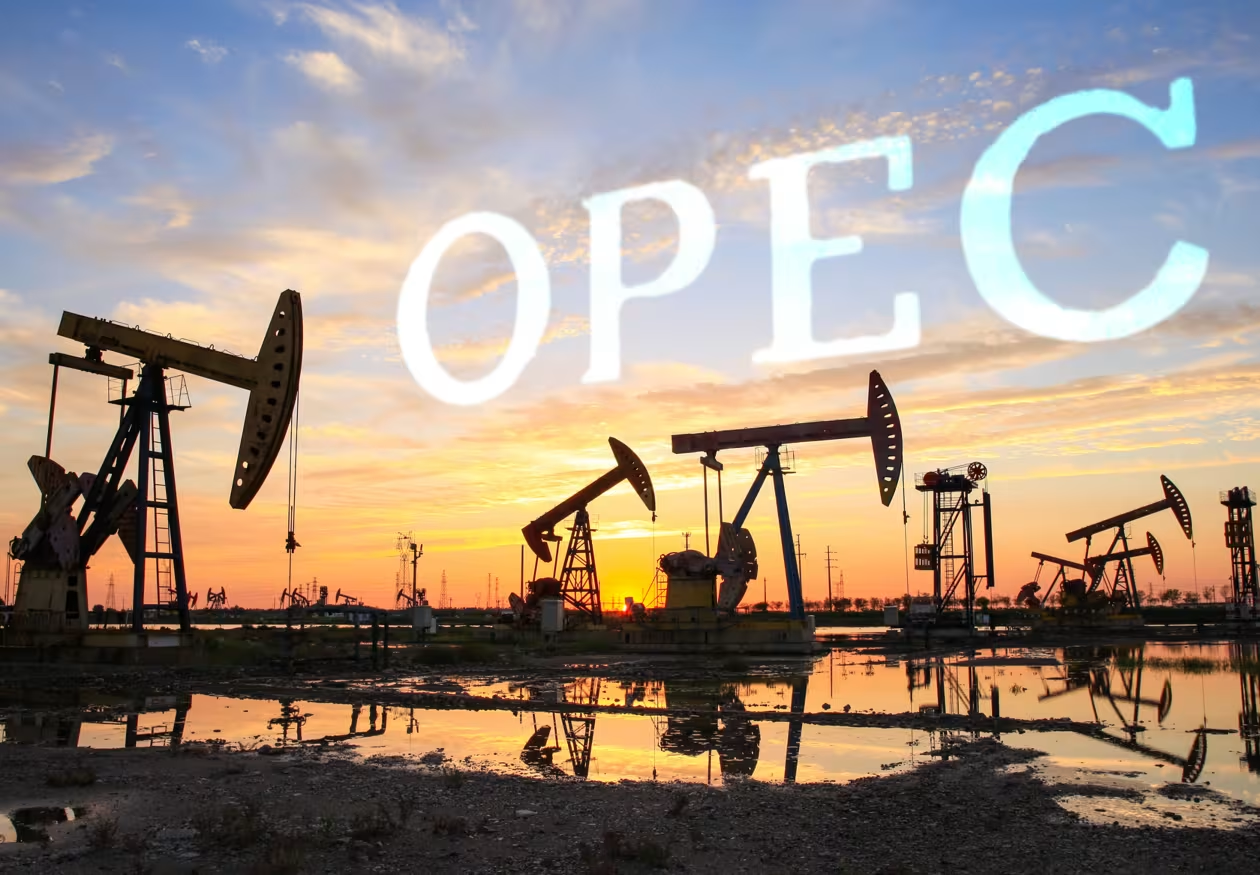

热门话题
在最新月报当中OPEC又一次将2024和2025年全球石油需求增长预期下调,这一举措引发了全球市场的高度关注;而另一方面特朗普上台后对于关税和战争的态度会对整个原油市场带来怎样的波动也被广泛关注。在这样的背景下,市场对未来油价走势的预期也更加复杂。OPEC之所以调整需求预期,主要原因在于全球经济增长放缓的压力,以及新能源的快速发展。OPEC在最新报告中将2024年石油需求增长从193万桶/日下调至182万桶/日,2025年则从164万桶/日下调至154万桶/日。这是OPEC连续第四个月下调石油需求预期,持续反映了对全球经济复苏的不确定性以及面临的能源转型的压力。

在OPEC开始持续下调石油需求预期后,市场对油价的下行风险表现出更高的关注。布伦特原油(UKOUSD)和WTI原油(USOUSD)四个月以来的价格都因此承压下行,市场的避险情绪明显上升,通过图像也可以看出来在这四个月期间布伦特原油和WTI原油整体都呈现出了下行的趋势。
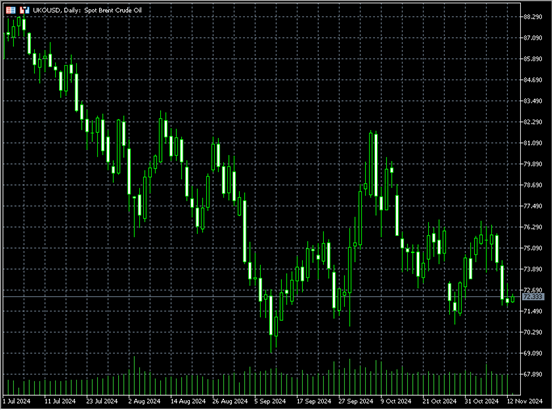

除了OPEC调整预期需求以外,石油市场的另一大变量在于地缘政治风险。中东地区作为OPEC主要成员国的所在地,一直以来都是全球石油供应的关键,任何地缘冲突都会导致石油供应不稳定,影响全球油价。特别是在以色列和巴勒斯坦冲突等热点事件的影响下,石油市场的供需形势变得更加复杂,油价在短期内易受到政治风险的冲击而剧烈波动。但现在市场有很大一部分人认为中东地区战争冲突目前带来的影响不及全球尤其是亚洲地区经济持续放缓所带来的影响大。中国作为全球最大石油消费国之一,其经济增长疲软导致石油需求预期下降,成为压制油价的一个重要因素。此外,欧美经济体在高通胀和经济滞涨的压力下,石油消费增长预期受限。这些因素共同作用,使得市场对石油需求的长期增长信心不足。在OPEC下调需求预期的背景下,巴克莱银行也对未来油市的稳定性做出了预测,该行指出,即使特朗普再次上任,其政策在短期内也不太可能对石油市场的基本面产生重大影响。巴克莱认为目前市场情绪主要集中在需求侧的负面因素上,而忽略了油市中的风险平衡。为此,巴克莱建议投资者可以考虑2025年12月的布伦特原油看涨价差,即做多油价的未来上涨空间,特别是在油市的供需平衡和地缘政治的不确定性因素下。这一策略体现出巴克莱对中长期油价仍然抱有相对乐观的态度。OPEC的下调预期还反映了石油行业所面临的能源转型压力,随着全球向可再生能源转型的步伐加快,电动车的普及和新能源技术的进步正在不断压缩石油的需求空间。欧洲各国已经设立了禁售燃油车的时间表,美国、加拿大等主要经济体也在大力推动新能源基础设施建设。这意味着,未来石油需求可能进一步萎缩,OPEC和主要产油国将不得不在供应端调整政策以适应新的格局。能源转型虽为长期趋势,但其带来的石油需求疲软正在给市场传递出明确的信号,这不仅影响了油价的短期走势,更是对整个石油市场长期前景的警示。

总的来看,OPEC的预期调整、地缘政治因素、全球经济放缓和能源转型等复杂因素共同影响了未来油价的波动性。OPEC的需求下调和巴克莱对油市未来的乐观建议又共同形成了市场风险的平衡视角。尽管石油需求增长放缓对短期油价产生压力,但从中长期来看,巴克莱认为油市仍有上行潜力,尤其在市场关注过度的下行风险和地缘不确定性持续存在的情况下。对于投资者而言,保持灵活性、密切关注政策和地缘政治动态将是应对油市波动的关键。同时,随着能源转型的推进,油市的传统逻辑或将被打破,未来油价在多重因素的作用下将持续波动,这为投资者在全球石油市场带来了新的风险与机遇。免责声明:GO Markets 分析师或外部发言人提供的信息基于其独立分析或个人经验。所表达的观点或交易风格仅代表其个人;并不代表 GO Markets 的观点或立场。联系方式:墨尔本 03 8658 0603悉尼 02 9188 0418中国地区(中文) 400 120 8537中国地区(英文) +248 4 671 903作者:Yoyo Ma | GO Markets 墨尔本中文部
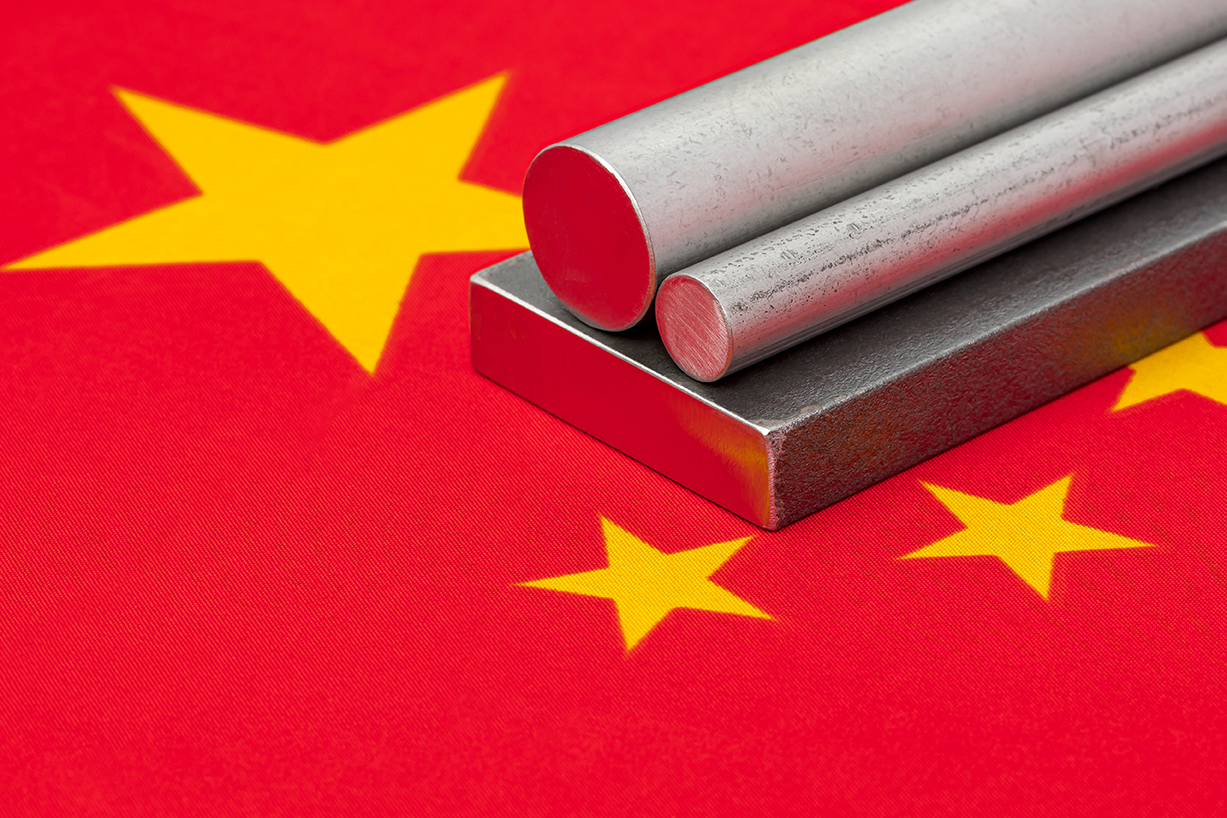

China’s recent shift in economic policy and its potential for fiscal stimulus reflect an evolving approach to support economic stability. Following previous monetary easing measures, including a reduction in the Reserve Ratio Requirement and interest rate cuts in late September, China’s National People’s Congress (NPC) Standing Committee has now approved a local government debt restructuring plan. This plan allows for up to RMB 10 trillion (~US$2.54 Trillion) in debt adjustments, including a one-time increase of RMB 6 trillion in the special debt ceiling over 2024-2026, and an additional RMB 800 billion in special bond quotas annually from 2024 to 2028.
These measures align with expectations, the catch – it’s estimated to add just 0.1 per cent to China’s GDP. Naturally this left the market disappointed and saw Chinese equities shredded. But it's more than the lack of direct demand-side stimulus.
It’s the vague guidance on the use of bonds for banking sector recapitalisation as well as poor outlining on housing inventory buy-backs, and idle land. It's all a bit, ‘nothing’. Now we admit market expectations had been high, so price falls were inevitable, but the metals prices post-meeting were telling from both a short- and longer-term perspective.
First support for the housing market may be limited in the near term, given that primary home sales for top developers turned positive up 15 per cent year-on-year from June last year and home prices rose slightly 0.4 per cent in 50 cities September to October. Second is a possible trade war and having some powder dry as it gears up for the next four years of a Trump 2.0 administration. Fiscal Stimulus is clearly going to be part of this.
And already we have seen Finance Minister Lan Foan, in comments to the South China Morning Post discussing this very point. He pointed out that China’s Ministry of Finance has a readiness for fiscal expansion starting in 2025 and that China’s current debt-to-GDP ratio (68%) provides fiscal headroom, especially in comparison to Japan (250%) and the U.S. (119%). So is that suggesting it’s a ‘when’ not an ‘if’?
From a trader and markets perspective the answer may come at the Central Economic Work Conference in December is expected to outline specific fiscal measures for 2025, potentially focusing on reducing housing inventory, boosting infrastructure, and enhancing social welfare and consumption. The market consensus is for between RMB 2-3 trillion in fiscal expansion over the next one to two years, likely with an initial emphasis on infrastructure investment over consumption support. We should point out this could be a “fourth strike and you’re out” territory as expectations for delivery since Gold Week celebrations have been 0-3, a fourth miss might see the markets completely ignoring what has been promised.
However if it does eventuate looking historically, such investment-heavy stimulus cycles have bolstered demand for steel and other raw materials. China’s past stimulus responses, particularly during the 2018-19 U.S. tariff period, included fiscal stimulus and currency depreciation, indicating that fiscal policy could adjust in response to global economic factors. However, China’s approach to fiscal expansion this time may differ slightly from past cycles: Reason 1: Steel Demand: Prior fiscal expansions, such as during 2009-2010 and the 2018-19 tariff period, drove strong steel demand growth.
Investment in steel-intensive infrastructure, for example, boosted annual steel demand by approximately 200 million tons (a 30 per cent increase) between 2016 and 2019, raising the steel intensity of GDP by 7 per cent. Given China’s high cumulative steel stock—estimated at around 8.5 tons per capita (approaching developed-nation averages of 8-12 tons per capita)—the scale of future infrastructure investment may be more limited, as large physical projects are increasingly complete and the need for new largest scale projects is moderating. Reason 2: Shift To Consumption and Social Welfare: Since 2018 China has subtly and gradually shifted fiscal efforts toward consumer support and social welfare to address deflation risks.
This shift is likely to accelerate, as policy moves to an emphasis on stimulating internal demand through social spending. Now historically China has often favoured investment-driven stimulus to support GDP growth targets, which could mean another infrastructure-led, steel-intensive approach if economic conditions demand it, albeit possibly on a smaller scale than in the past, but again 0-3 on promises, there are risks it doesn’t materialise this time around. The next part of the story for commodities and a China stimulus story is the impending trade war.
China is clearly facing headwinds for its exports, given the likely policy changes from the second Trump administration. The biggest issues are the 10 per cent tariff on all imports and up to 60 per cent on Chinese goods. The timing and specifics of the tariffs are uncertain, but using his 2016-2020 timelines as a guide it's likely to be one of the first programs enacted and new tariffs could emerge as early as the first half of 2025.
Currently, more than 20 per cent of China’s steel production is tied to exports—11 per cent directly and 12 per cent indirectly through products like machinery and vehicles—any new tariffs on Chinese goods would likely impact steel output and, subsequently, iron ore demand. During the 2018-19 tariff period, China’s direct steel exports to the U.S. declined, but this was balanced by growth in indirect steel exports via manufactured goods and bolstered by domestic infrastructure demand which is hard to see this time around. 2025 strategies China might deploy to counteract any new tariffs could include currency depreciation, reciprocal tariffs, re-routing exports to new markets, and increased fiscal and monetary stimulus. Interestingly the U.S. comprises only 1 per cent of China’s direct steel export market, it the larger share for indirect exports, particularly machinery ~20 per cent that is the issue.
Since 2018, China has expanded its steel-based goods exports by focusing on emerging markets—a resilience that will likely be tested further if tariffs intensify next year. So where does this leave iron ore? Current iron ore prices, hovering around US$100 per tonne, seem to reflect current market fundamentals pretty accurately.
The substantial net short positions in SGX futures, which were prevalent prior to the late-September stimulus, have notably diminished in the past 6 weeks China’s recent policy adjustments have mitigated the downside risks for steel demand for the remainder of 2024. This is coupled with solidifying demand indicators and restocking activities, which may bolster seasonal price strength as the year concludes. Nevertheless, the potential impact of a seasonal price rally may be constrained by relatively high port stock levels, which presently stand at about 41 days of supply which again underscores why price around US$100 a tonne is accurate.
Looking ahead to 2025, the Ministry of Finance in China signalling forthcoming fiscal expansion suggests a potential upside risk. However, potential new tariffs from the U.S. may pose challenges to steel export volumes, potentially counteracting the positive effects of domestic fiscal measures. China’s response to such tariffs—potentially through currency depreciation, trade redirection, or additional fiscal and monetary stimulus—will be crucial in mitigating these pressures.
But this would be a zero-sum game effect. Thus any upside risks are counted by downside risks – this leads us to conclude that China is not going to be the White Knight of the past. And that 2025 is going to be a tale of two competing forces that sees pricing see-sawing around but finding equilibrium at current prices.
This also leads us to point to equities – iron ore and cyclical plays have benefited strongly over the past 24 months on higher prices and the long COVID tail. 2025 appears to be the year that tail ends and a new phase will begin.
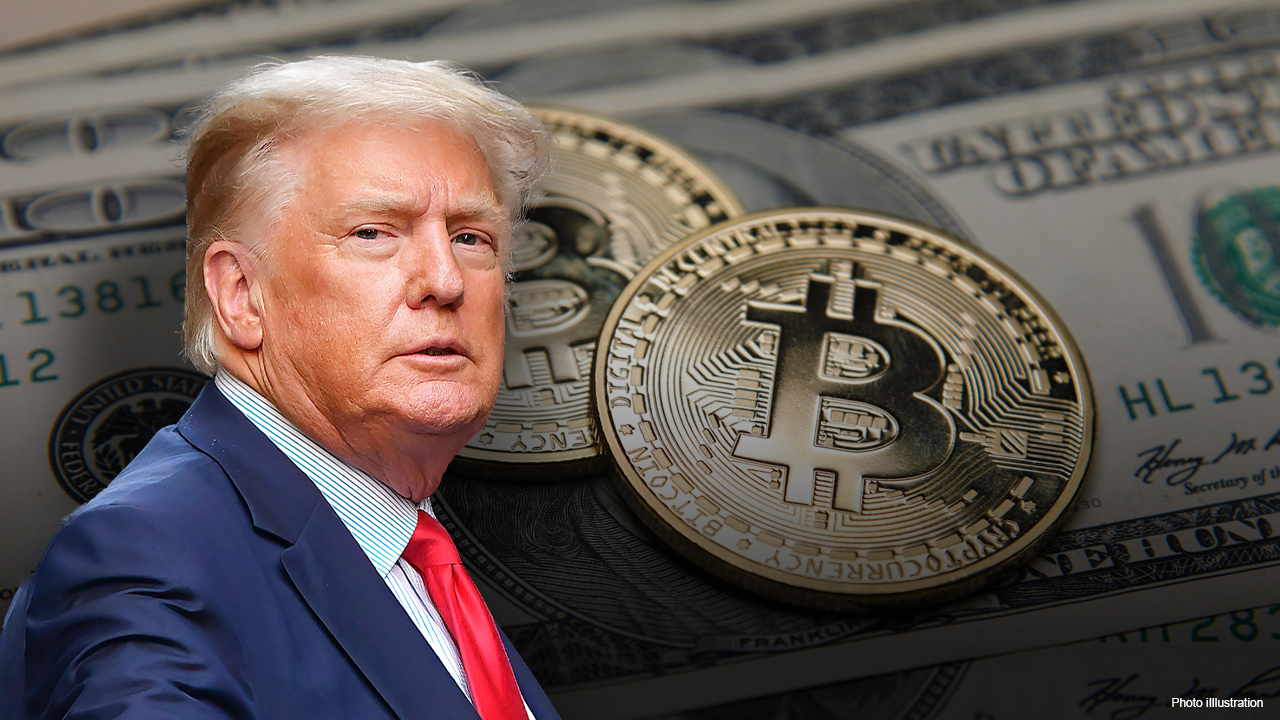

热门话题
特朗普上台后,会做很多颠覆性的创新推进,首当其冲的就是,敢于面对加密技术和去中心化技术对传统中心化货币信用体系的冲击。BTC价格在一周时间内快速上涨30%,最终突破9万美金,市值超过白银,估值1.72万亿美元,成为全球第八大资产。

特朗普8月份表示,JM货币可以“定义未来”,并补充称,他希望JM货币“在美国开采、铸造和制造”。这位当选总统还提议建立类似于美国战略石油储备的国家比特币战略储备,直接购买和投资JM货币作为国家安全措施。并且公开接受任何形式的JM货币捐赠。来自该领域的支持者们为特朗普大选也贡献了可观的真金白银。今年9 月,特朗普和他的子女创办了一家名为 World Liberty Financial 的新JM货币公司,意味着未来的总统亲自加入区块链经济系统中,和他的支持者们,尤其是马斯克,共同支持JM货币市场发展,同时也是受益人。特朗普也说了一句非常激进也有激情的话:“规则将由热爱你的行业的人而不是讨厌你的行业的人制定。”在特朗普赢的大选后,当天美国BTC ETF进入13亿美元新增资金。全球JM货币市场总值达到3万亿美元。

回到过去,看2021年6月,美国证券交易委员会主席加里·根斯勒(Gary Gensler) 在他上任后的首次演讲中表示,JM货币“充斥着欺诈、骗局和滥用”。美国监管机构和美联储共同认为,应该加强JM货币的监管。而目前,美联储理事沃勒表示,稳定币可能为金融系统带来好处。稳定币基本上是一种合成美元。在特朗普胜选后,开始表态支持和认可JM货币在经济系统中的作用。所以,目前美国从政府到监管机构,未来对JM货币的态度,都是开放和支持的。我们不做JM货币本身的价格预测,毕竟美国认可,不代表全世界任何国家都认可。但是,我们从牛市的舆论中,很容易看出来,未来还有更进一步的上涨空间。我之前多次提到,BTC就是JM货币领域的爱马仕。如果我们普通投资者,由于各类问题无法直接参与JM货币市场,或者不了解加密货币世界背后的技术和逻辑,我们可以曲线救国,通过购买与之相关股票进行投资,毕竟,股票各国政府都认可,区块链技术也都认可,股价同样会跟随整个JM世界版块的估值上涨。最推荐的,就是Coinbase。我记得我在2023年左右,公开的墨尔本大型金融讲座活动上,以及多次公开的视频网络研讨会中,都给出推荐,当时价格应该是50-110美金之间波动,而目前价格已经上涨到300美金附近。这家公司是在美国上市的JM货币交易所,只要有交易产生,就有钱赚。该平台持有约9,182枚BTC。所以,BTC价格上涨1万美金,该平台就赚1亿美金。在2024年第三季度,Coinbase报告净收入为7,550万美元,每股收益0.28美元,低于市场预期的0.45美元。收入为12.05亿美元,未达到预期的12.61亿美元。除此之外,GO Markets也给到大家一些区块链技术相关的股票参考:美股上市公司:MicroStrategy Inc. (MSTR):这家商业智能公司是全球持有BTC最多的上市公司之一,持有超过158,000枚BTC。该公司股价进入2024年,也是接近10倍涨幅。

Marathon Digital Holdings, Inc. (MARA):专注于JM货币挖矿,持有约13,286枚BTC。特斯拉公司 (TSLA):这家电动汽车制造商持有约10,500枚BTC。港股上市公司:众安在线 (6060.HK):通过旗下众安银行与多家JM公司合作,提供相关服务。BTC ETF:ARKB.CBOE - ARK 21Shares Bitcoin ETFBITB.NYSE - Bitwise Bitcoin ETP TrustBRRR.NAS - Valkyrie Bitcoin FundBTCO.CBOE - Invesco Galaxy Bitcoin ETFBTCW.CBOE - WisdomTree Bitcoin TrustDEFI.NYSE - Hashdex Bitcoin ETFEZBC.CBOE - Franklin Bitcoin ETFFBTC.CBOE - Fidelity Wise Origin Bitcoin TrustGBTC.NYSE - Grayscale Bitcoin Trust BTCHODL.CBOE - VanEck Bitcoin TrustIBIT.NAS - iShares Bitcoin Trust新的科技时代正在开启,AI和区块链技术在特朗普+马斯克时代,会快速发展。参与进未来财富增长的最便捷方式,就是购买股票成为股东或购买ETF。免责声明:GO Markets 分析师或外部发言人提供的信息基于其独立分析或个人经验。所表达的观点或交易风格仅代表其个人;并不代表 GO Markets 的观点或立场。联系方式:墨尔本 03 8658 0603悉尼 02 9188 0418中国地区(中文) 400 120 8537中国地区(英文) +248 4 671 903作者:Jacky Wang | GO Markets 亚洲投研部主管
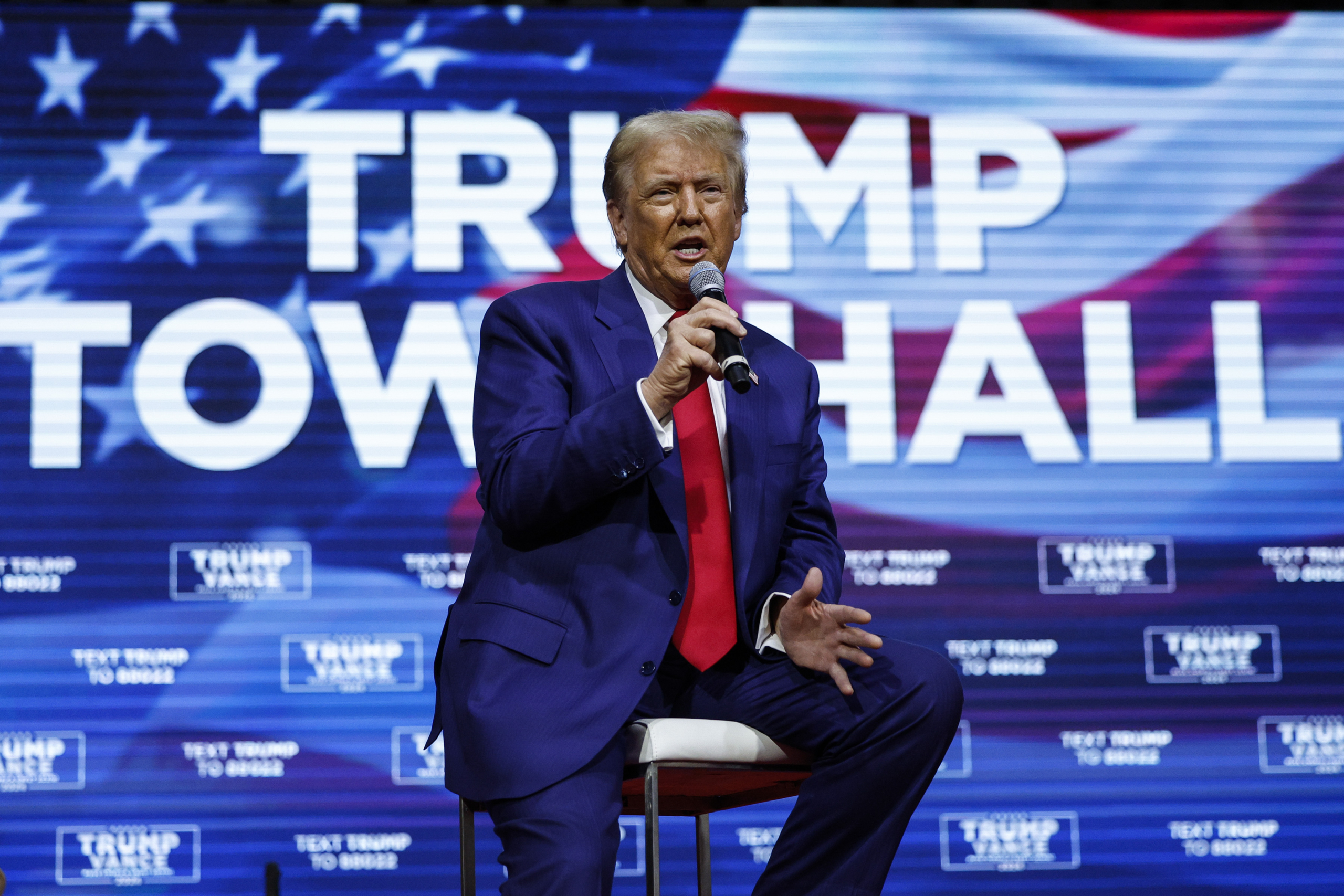

热门话题
周五美盘继续上冲,三大股指均收下小阳线,从媒体看,美股一旦持续上涨就有唱空声出现,本次大选后的走势直接扭转财报季的持续回调,三大股指创历史新高,是市场对特朗普当选以后的美国经济的肯定,美股牛市框架已经成型,若数据不出意外,很有可能直接对接圣诞元旦行情而不需要过多回调。

AI板块涨跌不一,特斯拉的强势开始持续体现,年初至今净涨幅不到30%,过去两年股价没有其他七巨头的表现,现在特朗普上台,特斯拉持续上涨是合情合理的,$300大关压力已经被突破,股价周五放量大涨8.19%冲上$320,距离前压力$384也不遥远,持有特斯拉中长期都是很有上升空间的选择。核能铀矿继续回调,国际铀价没有反弹迹象,周五澳铀的反弹今天又会回吐,但美国核技术股逢回落就可进场。周末比特币冲上八万美元大关,再次验证美轮减半后会走出大涨波段的规律。本周美国10月CPI年率预期较前值反弹0.2%至2.6%,这也是因大选推迟给出的最新预测,月度数据和核心CPI保持增幅不变,通胀数据依然可控,增速小幅反弹将加剧美联储降息节奏,前半周对美股形成一定压力。周四PPI预期反弹幅度也较大,从前值1.1%反弹至2.3%,但PPI在2%附近依然不差,对股市的影响没有CPI关键。周五鲍威尔将再度在活动上发言,预计其言论也将继续温和中性。目前马斯克已经公然支持特朗普在未来干预美联储,鲍威尔的岗位压力也越来越大,更不可能有激进政策推行了。
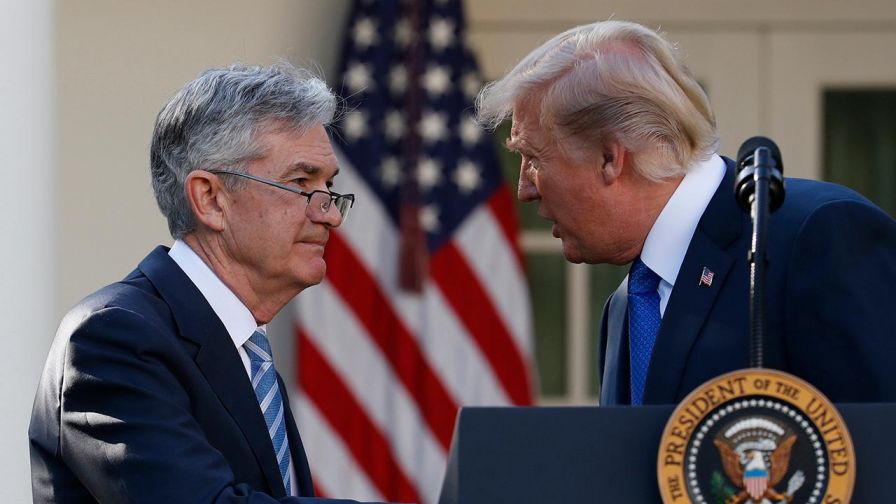
美元指数周五继续大涨,再次逼近105大关。近期美元暴涨暴跌的趋势短期难以改变,可能要等到特朗普正式上任才会压制住涨势。金价再度暴跌至2700以下,宽度剧震持续了数日,随着中东局势在特朗普上任过渡期的扑朔迷离,金价接下去几个月也难以稳定。恐慌指数继续回落相对较容易判断,继续兑现大选前预期的下行波段。油价周五扩大跌幅,美油回到$70平台,也符合逢高做空的预期,中期油价会进一步下行。外汇方面,美元的不稳定表现令汇市震荡加剧,澳美再度回到0.66以下,但澳元既有贵金属等原材料和能源价格回落影响,又有澳联储不降息助推,短期陷入大波动也无法避免。美元人民币继续保持在7.2以下。周末中国出台14.3万亿隐形地方债化债政策,有望进一步助推股市并解放地方政府财政困难。因此沪深两市上周的表现基本兑现了人大召开是的“任务”,而A50和HK50的表现明显没有匹配,若本周A股继续稳健上行,以上指数也会反弹匹配A股走势。免责声明:GO Markets 分析师或外部发言人提供的信息基于其独立分析或个人经验。所表达的观点或交易风格仅代表其个人;并不代表 GO Markets 的观点或立场。联系方式:墨尔本 03 8658 0603悉尼 02 9188 0418中国地区(中文) 400 120 8537中国地区(英文) +248 4 671 903作者:Xavier Zhang | GO Markets 高级分析师

